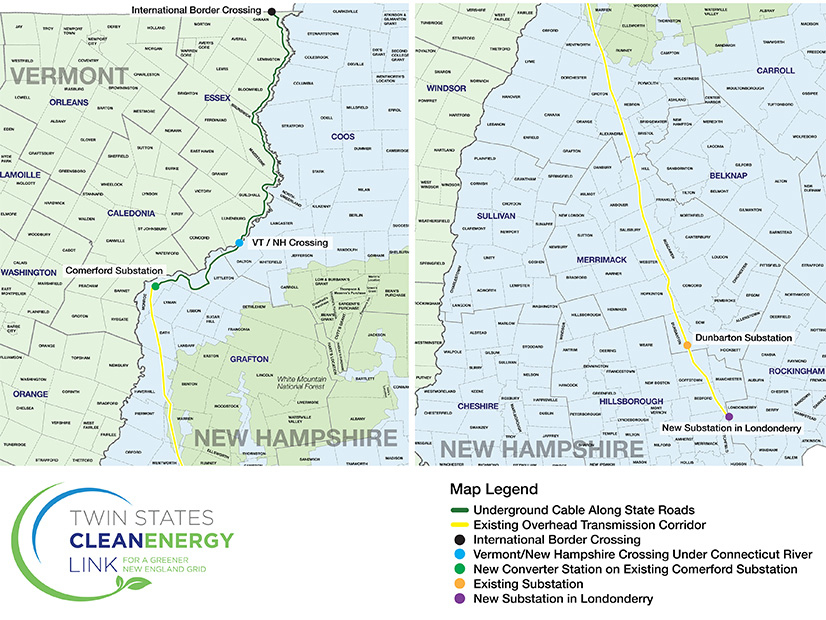
National Grid (NYSE:NGG) is proposing a 1.2-GW transmission project to carry power from Quebec hydroelectric plants to southern New England through Vermont and New Hampshire.
The Twin States Clean Energy Link has a preliminary cost estimate of $2 billion. It would entail a new HVDC line running 75 miles underground from the Canada-Vermont border to a retired converter station in Monroe, N.H., that would be repurposed as part of the project.
The existing 110 miles of above-ground AC infrastructure would be upgraded between Monroe and a new 345-kV substation Londonderry, N.H.
National Grid is partnering with the nonprofit Citizens Energy on the project. The Northeastern Vermont Development Association would aid in programming the estimated $100 million of community benefits associated with the project, and the International Brotherhood of Electrical Workers would support construction.
The company is promoting the project as a way to reduce dependence on fossil fuel generation when variable wind and solar power output lag. It would reduce New England’s carbon emissions by millions of metric tons per year and save ratepayers billions of dollars over the first 15 years, developers said.
National Grid said it has submitted the proposal to the U.S. Department of Energy’s Transmission Facilitation Program (TFP), a $2.5 billion funding stream created by the Infrastructure Investment and Jobs Act.
The company said federal investment and initial cost recovery through TFP is critical to Twin States moving forward on the planned timelines. A spokesperson said Friday the earliest construction could begin would be in late 2026.
The line would be bidirectional, able to export power to Quebec if the profusion of solar and wind projects being planned and built in southern New England should generate a surplus of electricity in a period of low demand.
There will be demand for it on the other side of the border: Quebec is mounting a clean-energy transition just as New England is, and Hydro-Quebec in its recent strategic plan forecasts a more than 50% increase in demand for its electricity through 2050.
The government-owned utility reported record income in 2022, thanks to high electricity prices and heavy exports, but reports by Bloomberg and other media outlets suggest its aggressive marketing will soon leave it short of power for Quebec’s own needs. It has begun planning to add generation from solar, wind and other renewable sources.
Slow Process
Building transmission lines to carry Quebec’s hydroelectric power south to the U.S. grid has proved challenging at times.
There has been strong local opposition from people who do not want to look at power lines or see trees cleared to build them; criticism from activists that hydropower is not as benign for the environment as advertised; and extensive regulatory processes to navigate.
New Hampshire shot down Eversource Energy’s plan to build the 1.09-GW Northern Pass line in 2018. (See New Hampshire Rejects Permit for Northern Pass.)
Avangrid’s 2017 proposal for the 1.2-GW New England Clean Energy Connect line in Maine has stalled amid multiple legal challenges. (See New England Clean Energy Connect Wins Court Battle.)
The 1.25-GW Champlain Hudson Power Express, first proposed in early 2010, finally began construction in New York early this year. Its projected completion is in 2026. (See Champlain Hudson Power Project Receives Landmark Delivery.)
National Grid is emphasizing that construction of the Twin States line would have a light impact and heavy benefit for the communities through which it would pass. The underground portion of the line would run along state roads, reducing its visual and environmental disruption. The above-ground portion would mostly entail replacing existing wires and reinforcing existing structures.
National Grid and its partners did not formally announce the proposal, but it gained public attention last week when New Hampshire Gov. Chris Sununu (R) threw his support behind it.
“New Hampshire is always looking to put solutions on the table that lower energy rates for consumers, and the Twin States Clean Energy Link makes use of clean, renewable energy to do just that,” Sununu said. “With a low-impact plan that utilizes already existing infrastructure, this project is a win-win for families and businesses across the Granite State.”
In a letter to U.S. Energy Secretary Jennifer Granholm, Sununu endorsed the project for inclusion in the TFP and said it would have the added benefit of allowing small renewable energy projects to be developed in northernmost New Hampshire.

